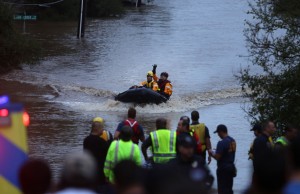Many Texas Communities Follow ‘Minimum Standards’ Or Less When Regulating Floodplains
MAP BY MICHAEL MARKS. A map of Texas Counties that participate in the National Flood Insurance Program. Counties in gray have insurance, counties in yellow have never had insurance, and counties in red do not currently have insurance, but have at some point. NOTE: Cities and towns may participate in the program even if their county does not.
The floods that killed five people and damaged over 1,000 homes in Austin on Halloween morning threw the danger of floods into stark relief. But when it comes to guarding against risky development in flood-prone regions, there’s little consistency from one Texas community to the next, with some areas still lacking any regulation.
The reason goes back to the way the state and local communities choose to adopt, or not adopt, the National Flood Insurance Program.
‘I’d rather move out’
Patti Farr is one of the thousands of people impacted by the Halloween Floods. In a waiting room of a Red Cross temporary assistance center in Austin, she told StateImpact Texas how she lost everything. But she still counts herself luckier than many, because Farr and her husband had flood insurance required as part of their mortgage.

Mose BUchele
Patti Farr says she lost "everything" in the flood. She's waiting to see what her flood insurance will pay out.
When she spoke to StateImpact Texas she didn’t know how much she would receive.
“I’d rather just move and get out [of the floodplain]. But I don’t know what options I have [because] I owe a mortgage,” she said. “So the flood insurance may be enough to just cover that, and then of course I’ll just have to replace everything else.”
Farr’s insurance is made possible because Austin participates in FEMA’s National Flood Insurance Program (NFIP). Under that program, local governments promise to regulate building in floodplains. In exchange for regulating, residents can access federally-subsidized insurance.
But many people who work on flood issues say the federally-mandated regulations are often not enough.
‘Basic Level’ of Protection
“I would call it the ‘basic level,'” Chad Berginnis, the Executive Director of the Association of State Floodplain Administrators, told StateImpact Texas. “We like to say that while the standards of NFIP are a good start, they should never ever be a finish point for states as they deal with flooding.”

Jorge Sanhueza-Lyon/KUT News
First responders pull flood victims from a flooded South East Austin neighborhood.
In the case of Austin, City officials say local regulations are more stringent than FEMA standards. They point to a ranking awarded by FEMA to back up the point.
“The Community Rating System is a FEMA program that rewards communities that go above and beyond, by providing a discount on flood insurance premiums for anybody in the city,” Kevin Shunk, a City of Austin Floodplain Administrator told StateImpact Texas.
The city of Austin ranks a “class six” out of ten with “class one” being the best rating. But even within that framework, building on floodplains is still allowed under exceptions in city code.
“If anyone would like to develop in the hundred-year floodplain, they would need to get a variance, and that variance needs to go to city council for approval,” Lynne Lightsey, a spokesperson for the City’s Watershed Protection Department told StateImpact Texas.
North of Austin, in the booming suburbs of Williamson County, it’s possible to see other ways growth can push the limits of safety. Below an old soil conservation dam, houses and roads have sprung up that would be in the direct path of a flood if the dam were to fail.
“In the NFIP minimum standards, there are actually zero road construction or road resiliency requirements,” the Floodplain Administrators Association’s Berginnis said when told about the road.
“Either you go by minimum standards, or the state has some standards or requirements that go above the minimum standards.”
A Patchwork of Regulation
Because floodplain management is left up to local governments in Texas, the state is a patchwork of different rules and regulations. It’s not like that in some other states.
“In Illinois, in Wisconsin, in Indiana, you have some higher standards, for instance, for flood ways,” says Berginnis. “Other states actually have programs where they may have a state permit that’s required in addition to a local permit.”
But in Texas, there are still counties that have no regulation for building in floodplains
Roy Sedwick, director of the Texas Floodplain Management Association, says his group tried to get a law passed that would mandate communities to participate in the flood insurance program, but were unsuccessful.
“In Texas, you know, we’re a very strong private property rights state, so any time you start talking about more regulation and more enforcement it always meets with a lot of opposition,” Sedwick told StatImpact Texas.
It’s still an open question how the Austin will respond to recent floods. If it can find the money — possibly with disaster aid from the federal government — it could try to buy out properties in the floodplains of South East Austin.
Sitting in the assistance center waiting room, flood victim Patti Far said she’d love to move to higher ground.
“I will check with the city and find out where the flood zones are, and not go there,” Farr said. “I might go find me a mountain … or build a mountain myself.”

